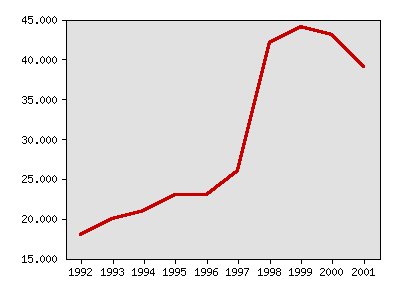What were things like in 2002?
The following idicator summary is from the 2002 Minnesota Milestones and does not neccessarily reflect the current data trends.Indicator : Welfare to work
Rationale: This measure gives an indication of how successful welfare recipients are in moving toward economic self-sufficiency.
About this indicator: The percentage of welfare households with an adult working increased dramatically after welfare reform in 1996. The trend was already moving upward in the early 1990s, but after federal welfare reform in 1996 established work requirements and welfare time limits, the percentage increased from 26 percent in 1997 to 43 percent in 2000. However, in 2001, the percentage declined slightly to 39 percent.
Minnesota's Family Investment Program (MFIP) requires welfare recipients to find work or enter training within six months, or sooner if required by the county. Changes in the law made it easier for people to receive assistance even after getting a job, in order to help in the transition to self-sufficiency.
Percentage of welfare households with an adult working

| Year | Data |
|---|---|
| Percentage of welfare households with an adult working, Minnesota Department of Human Services | |
| 1992 | 18% |
| 1993 | 20% |
| 1994 | 21% |
| 1995 | 23% |
| 1996 | 23% |
| 1997 | 26% |
| 1998 | 42% |
| 1999 | 44% |
| 2000 | 43% |
| 2001 | 39% |
For comparison: Nationally and in Minnesota, dramatic declines have occurred in welfare caseloads since the mid 1990s. While all states have welfare programs, data is not comparable between states because of differences in the programs.
Things to think about: Progress in moving people from welfare to work in the late 1990s occurred during a period of strong economic growth. It may be more difficult to move welfare recipients into employment in a slower economy. Many welfare advocates are concerned about the fate of people who are not able to achieve self-sufficiency within the federal five-year limit. There are also different circumstances that may result in a welfare household not maintaining self-sufficiency, from the economic conditions in the area to the health of the caregiver or the children.
Technical notes: This data reports employment rates for Aid to Families with Dependent Children (AFDC) cases (prior to January 1998) and Minnesota Family Investment Program (MFIP) cases (beginning January 1998.) If a person had earned income (regardless of whether they still received MFIP assistance) the individual was counted as working. The increase between 1997 and 1998 reflects the effect of the requirement that welfare recipients find work or enter training within six months (or sooner if required by the county). Data reported here for 1992-96 is different than data reported in Minnesota Milestones 1998. Data in Minnesota Milestones 1998 was based on a Department of Human Services quality control sample of welfare cases. The new data here is based on all MFIP cases. The data are point in time measures from July of each year. The percentages reflect the percent of all MFIP cases with an eligible adult who had any earnings during July of the year in question.
Sources:Minnesota Department of Human Services, www.dhs.state.mn.us/ecs/welfare
Acton Institute Policy Forum, October 2001, www.acton.org
Related 2002 Milestones indicator:
Other related indicators:
- Minnesotans enrolled in MinnesotaCare, Medical Assistance and related health care programs (Minnesota Department of Human Services, www.dhs.state.mn.us/ecs/welfare)
- Minnesotans receiving public child care subsidies (Minnesota Department of Children, Families & Learning, http://cfl.state.mn.us)
Local data:





